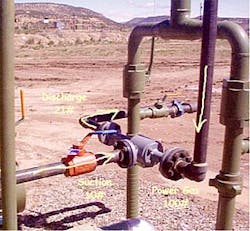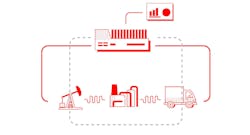Installation of ejectors has extended the life of 17 mature coalbed methane wells operated by BP America Production Co. in northwestern New Mexico and southwestern Colorado.
David Simpson, senior staff mechanical engineer for BP in Farmington, NM, says "The main thing we're doing is applying a little extra horsepower to pull on the tubing in the wellbore, while we produce most of the gas in the tubing-casing annulus."
He explains that these wells are late in their lives and because of the low reservoir pressure, as low as 45-60 psi, rod pumps require more net positive suction head (NPSH) than is available, and in some cases, 100 ft of water above a pump is more backpressure than the reservoir can tolerate.
Ejectors
Croll-Reynolds Co., Westfield, NJ, manufacturer of the ejectors describes them as a pumping device with no moving parts that uses a high-pressure gas as a motivating force.
It says strictly speaking, all gas-vapor motivated units are known as ejectors, while liquid motivated units are known as eductors; however, the terms are often used interchangeably.
In operation, a high-pressure motive gas enters at low velocity and expands through a converging-diverging nozzle. This results in a decrease in pressure and an increase in velocity.
Meanwhile, the fluid enters at the suction inlet. The motive fluid, which is now at high velocity, entrains the suction fluid and combines with it.
The two fluids are then recompressed through the diffuser. They discharge at an intermediate pressure that is higher than the suction pressure but much lower than the motive pressure.
Coalbed methane application
During the past 4 years, BP has installed 17 small, high-pressure ejectors both downhole and on surface.
Its basic well configuration is a 7-in. hole to about 3,000 ft that is lined with 7-in. casing containing a 23/8-in. tubing string.
The wells employ 160-625 hp flooded-screw compressors to pull gas from the tubing-casing annulus and send part of the compressor discharge back to the ejector.
Simpson says this requires about 16 hp and reduces by a few pounds the pressure on the tubing.
The 11/2-in. ejector, shown here, helps BP manage produced water from its coalbed methane operations in northwestern New Mexico and southwestern Colorado (Fig. 1).
"We're using the ejectors to increase the velocity of the small stream of gas, enabling it to lift the water in the 2-in. tubing, while we produce the big stream from the annulus," he says.
To date BP has installed fifteen 2-in. ejectors, two 3-in. ejectors in larger tubing, and two 11/2-in. ejectors for surface-water management at water collection points in the gathering system (Fig. 1).
Simpson says that that flow rates through the 2-in. ejectors are about 168 Mscfd or 300 lb/hr, which is enough velocity in 23/8-in. tubing to lift water. Wells with 3-in. tubing require the larger 3-in. ejector.
He explains "To size the ejectors, we determined the critical velocities we needed in the tubing and converted them to mass-flow rate. Basically we're pulling 300 lb/hr through the tubing day in and day out and getting good velocity."
The ejectors are made of cast steel with stainless steel nozzles and have no moving parts to wear. The first two, installed 4 years ago, were removed and an inspection showed that both looked perfect on the inside, according to Simpson.
Simpson says, "The ejectors allow us to do a better job managing liquid level in gas wells with the lowest backpressure of any technology we've investigated."


